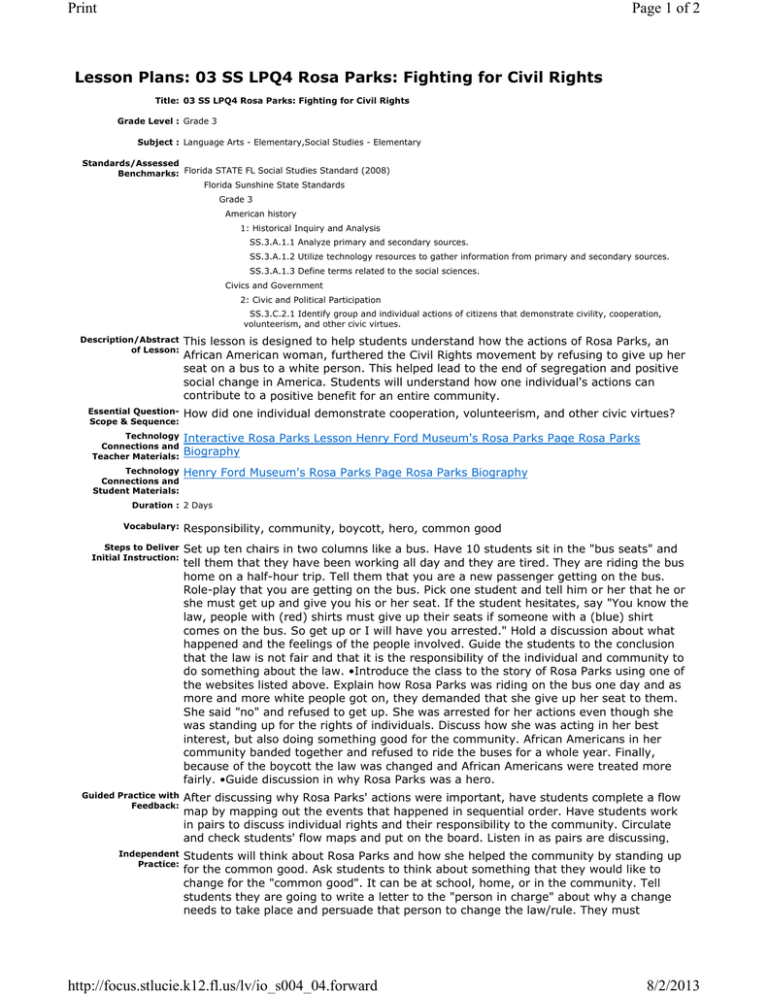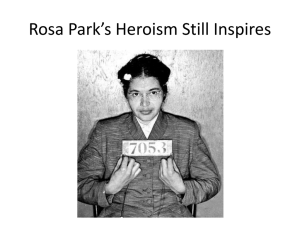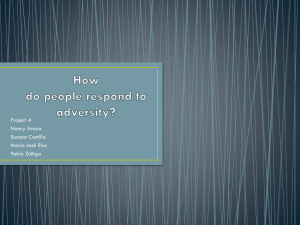Lesson Plans: 03 SS LPQ4 Rosa Parks: Fighting for Civil... Page 1 of 2 Print
advertisement

Print Page 1 of 2 Lesson Plans: 03 SS LPQ4 Rosa Parks: Fighting for Civil Rights Title: 03 SS LPQ4 Rosa Parks: Fighting for Civil Rights Grade Level : Grade 3 Subject : Language Arts - Elementary,Social Studies - Elementary Standards/Assessed Benchmarks: Florida STATE FL Social Studies Standard (2008) Florida Sunshine State Standards Grade 3 American history 1: Historical Inquiry and Analysis SS.3.A.1.1 Analyze primary and secondary sources. SS.3.A.1.2 Utilize technology resources to gather information from primary and secondary sources. SS.3.A.1.3 Define terms related to the social sciences. Civics and Government 2: Civic and Political Participation SS.3.C.2.1 Identify group and individual actions of citizens that demonstrate civility, cooperation, volunteerism, and other civic virtues. Description/Abstract of Lesson: Essential QuestionScope & Sequence: This lesson is designed to help students understand how the actions of Rosa Parks, an African American woman, furthered the Civil Rights movement by refusing to give up her seat on a bus to a white person. This helped lead to the end of segregation and positive social change in America. Students will understand how one individual's actions can contribute to a positive benefit for an entire community. How did one individual demonstrate cooperation, volunteerism, and other civic virtues? Technology Connections and Teacher Materials: Interactive Rosa Parks Lesson Henry Ford Museum's Rosa Parks Page Rosa Parks Biography Technology Connections and Student Materials: Henry Ford Museum's Rosa Parks Page Rosa Parks Biography Duration : 2 Days Vocabulary: Steps to Deliver Initial Instruction: Responsibility, community, boycott, hero, common good Set up ten chairs in two columns like a bus. Have 10 students sit in the "bus seats" and tell them that they have been working all day and they are tired. They are riding the bus home on a half-hour trip. Tell them that you are a new passenger getting on the bus. Role-play that you are getting on the bus. Pick one student and tell him or her that he or she must get up and give you his or her seat. If the student hesitates, say "You know the law, people with (red) shirts must give up their seats if someone with a (blue) shirt comes on the bus. So get up or I will have you arrested." Hold a discussion about what happened and the feelings of the people involved. Guide the students to the conclusion that the law is not fair and that it is the responsibility of the individual and community to do something about the law. •Introduce the class to the story of Rosa Parks using one of the websites listed above. Explain how Rosa Parks was riding on the bus one day and as more and more white people got on, they demanded that she give up her seat to them. She said "no" and refused to get up. She was arrested for her actions even though she was standing up for the rights of individuals. Discuss how she was acting in her best interest, but also doing something good for the community. African Americans in her community banded together and refused to ride the buses for a whole year. Finally, because of the boycott the law was changed and African Americans were treated more fairly. •Guide discussion in why Rosa Parks was a hero. Guided Practice with Feedback: After discussing why Rosa Parks' actions were important, have students complete a flow map by mapping out the events that happened in sequential order. Have students work in pairs to discuss individual rights and their responsibility to the community. Circulate and check students' flow maps and put on the board. Listen in as pairs are discussing. Independent Practice: Students will think about Rosa Parks and how she helped the community by standing up for the common good. Ask students to think about something that they would like to change for the "common good". It can be at school, home, or in the community. Tell students they are going to write a letter to the "person in charge" about why a change needs to take place and persuade that person to change the law/rule. They must http://focus.stlucie.k12.fl.us/lv/io_s004_04.forward 8/2/2013 Print Page 2 of 2 persuade the person and explain why this is important and how it will benefit the common good of other people. ESE/ESOL Accommodations & ESE/ESOL Strategies: Lesson Closure/Review: Assessment with Clear & Compelling Product Standards: Instead of writing the letter independently, students may work with a partner or use a picture to help communicate. Review how the first lesson began (one student being forced to get out of his/her seat on the bus) and how they felt at the time. Have students share their letters with the group or aloud to the class. Students will demonstrate their understanding of the effect of of Rosa Parks' actions in their written outlines and explanations of individual rights and community responsibility. Monitor student letters to assure that students use quality writing and express sincere feelings about what it is they would like to change for the common good of the community. Creator : Social Studies Content Team Date Created : November 29, 2011 Date Modified : June 20, 2012 http://focus.stlucie.k12.fl.us/lv/io_s004_04.forward 8/2/2013






